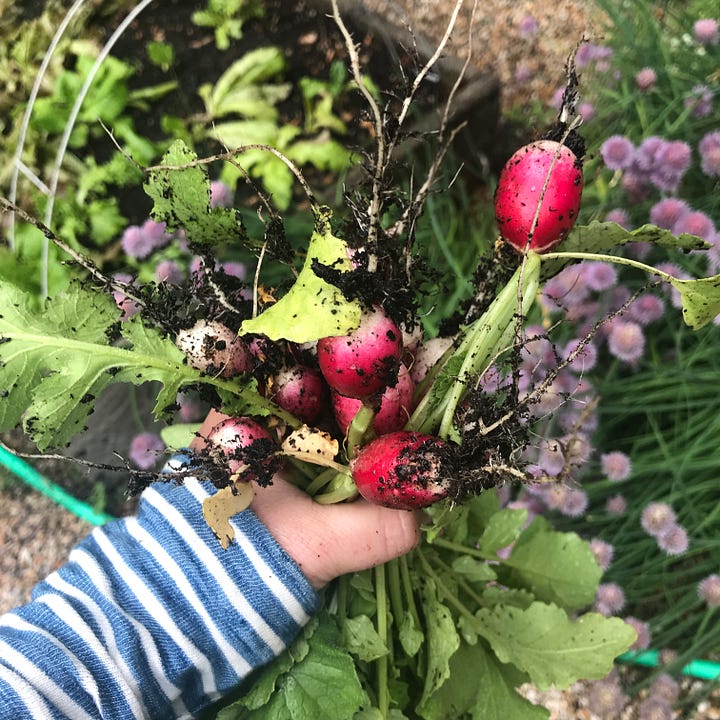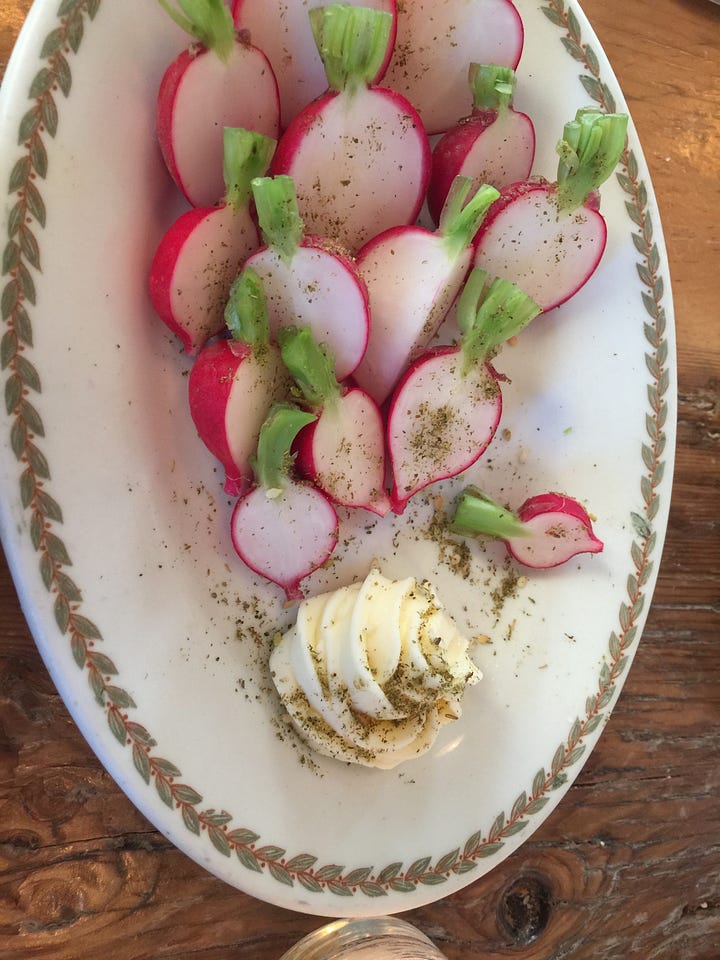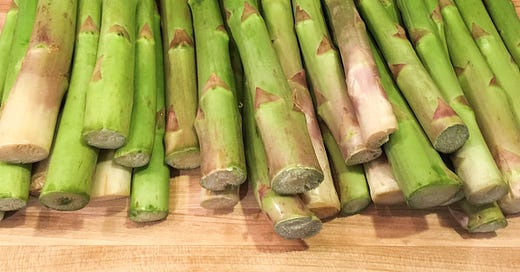Since the publication of Permission at the beginning of March, I’ve had many conversations on subjects ranging from allowing ourselves the space/time/trust to make art (be it narrative or musical or visual), to the dangers inherent in telling our stories, which is at the center of Permission. And one of the questions that has come up repeatedly is:
Who do we think we are to take our work seriously in a world that appears to be falling apart?
In other words: Why? Why do we do this? Why do we even bother? Does it matter?
I sit with this question all the time. In October, I wrote about it in this space, when it took on the hue of cynicism. And all I know is this, and I say it without a shred of irony, hyperbole, or sentimentality: I am being saved by art. Whether it’s a re-read of
‘s Wintering or Soetsu Yanagi’s The Beauty of Everyday Things, Edmund de Waal’s The Hare with Amber Eyes, Wallace Stegner’s Crossing to Safety or Gail Caldwell’s Let’s Take the Long Way Home; or spending time in my hideous mess of a garden; or standing in my kitchen in front of a platter of greens and French breakfast radishes with sweet butter, and wondering, as I do every spring, why I am not a vegetarian; or picking up my guitar and playing music; or going for a walk without headphones; or spending actual time looking at the things that are hanging on my walls instead of forgetting about them.It all tells a story: art, music, narrative, cooking, fashion, the natural world.


In her book, On Not Knowing, Emily Ogden writes:
Stories suture up our parts against a primordial awareness that we are in pieces. They knit our bodies and our worlds into shapes we can use that make sense to us, shapes that can break and be repaired in sufficiently predictable ways to allow us to live….Stories make these shapes out of a prior, if not original, perception of fragments.
We live at the core of uncertainty. We live in a state of What If — an acute condition of fragmentation and distraction, of bits of ourselves constantly being pulled apart like the insides of a croissant. Flakes of laminated pastry flying everywhere.
Last Sunday was Mother’s Day, and Susan and I drove down to the city to spend it with Rita, who is 89 and very much coming into what Doris Grumbach called the end zone. My mother — my stunning, tempestuous, former model/television singer mother and the main character in Motherland — is now exclusively wearing sweatpants and sweatshirts, mostly stained; she refuses to allow anyone to launder them. Her kitchen is a mess because she believes she’s allergic to her dish soap and her sponge. It utterly breaks my heart for her, despite the complexities of our relationship. Two years ago, people would stop her on the street and ask if she was famous because they recognized her from TikTok, and her singing days in the nineties. But her life is now chaotic and fragmented: there is what was before, and there is what is now. There is the raging NPD, abusive, cruel, vengeful woman who openly blames me for her failure at stardom; there is the kind, tender, and often hilariously funny woman from whom I get my love of animals and (limited) sartorial sensibility (I at least know enough not to buckle the belt on my trenchcoat). There is the man-crazy woman who will do anything — literally anything — for male attention. There is the truth-teller and the fibber who carries kabbalah stones in her pocketbook, even though she hasn’t set foot in a house of worship since long before I was born. There is the furious woman who demands I buy her an iPhone, but who doesn’t know where the on button is on the MacBook Air I bought her three years ago, or how her cordless house phone works. There is the woman who cursed my father and stepfather while they were alive, and now wishes, through streaming tears, that they were here.
We are in the hands of men whose power and wealth have separated them from the reality of daily life and from the imagination. We are right to be afraid, wrote Grace Paley.
When we returned to her apartment after a lovely lunch at an East Side restaurant, we told her that we were going to the UK for a few weeks at the end of May. Her questions: What if. What if she needed us. What if her teeth fell out and there was no one to take her to the dentist. What if. What if something went wrong with the apartment. What if she needed to go to the doctor. What if her sneakers were the wrong size. What if she fell. What if she needed to go to the bank. What if one of her aides didn’t show up. What if they showed up on the wrong days. What if she wanted to go back to the performer’s club she’s a member of, but there was no one to take her. What if she ran out of makeup. What if she needed a haircut. What if she lost her keys.
All of these things have happened in the past and continue to happen without warning, almost daily. Sometimes, they’re clumped together. Sometimes they’re not. Sometimes, things are quiet, but only rarely.
My own fears for her safety are also fragmented and can send me into a chaotic tailspin: what if she has an accident, and a decision has to be made, and I’m not there. What happens if she dies. What happens if she loses her health insurance. What happens if she has a stroke in the night? What happens if they take her to the hospital and her man-friend, who is younger than my wife, neglects to tell them that they are not married or that she has a daughter, and her daughter is in charge of her care and decision-making? What if.
I don’t know a lot, but I know this much is true: any of these things can happen whether I’m at my home in Connecticut, two hours away from her, or five hours away, in London. Chaos and fragmentation know neither distance nor time zone. But I am absolutely envisioning myself walking around the White Garden at Sissinghurst and having her call my cell to tell me she’s allergic to the color pink. (She believes she is, except for makeup.)
Any seemingly mundane practice that requires some level of undivided attention keeps us whole.
I used to believe that my own experience with fragmentation was the direct result of the Covid stroke I had in 2020, in the early days of the pandemic. For a year, I struggled to organize my life, my thoughts, my health. Every day is still an exercise in not letting the world tear me apart again, but it is an uphill battle because fragmentation — synonymous with chaos — is our current national state, by design. Our political discourse uses chaotic fragmentation to keep us all dancing as if we were walking barefoot on hot coals: it pulls us this way and that, blares at us, whispers terror in our ears, shocks us, cajoles us, assures us, divides us, defines us. It counts upon our frayed and frazzled human condition to siphon what it needs from us, leaving us as full of holes as an old boat. And no amount of patching will keep us from sinking, exhausted and distracted.
But we are not, ultimately, in pieces. Our stories keep us whole, as Emily Ogden says. Living with mild dementia, my mother still manages to find grounding and stability in talking about music and remembering her days in the spotlight. Slowing down keeps us whole. Being with children keeps us whole. Breaking bread keeps us whole. Getting our hands filthy in garden soil keeps us whole. Any seemingly mundane practice that requires some level of undivided attention — writing, painting, reading, cooking, keeping a journal, meditating, praying, swimming, running, sex — keeps us whole. Art-making keeps us whole.
We are in the hands of men whose power and wealth have separated them from the reality of daily life and from the imagination. We are right to be afraid, wrote Grace Paley. I read her words this way: the mundanity of daily life is what keeps us tethered and whole, and therein lies its beauty, and the significance of what gives our lives meaning amidst the chaos.
After surviving cancer twice, losing her husband in her early fifties, living with profound anxiety and mental illness that kept her spinning from sunup till sundown, my late mother-in-law spent her good days poking at her garden, making beauty wherever she could; when it was time to talk about moving her into an assisted living facility, she said she’d rather die. What about my garden, she asked. She had the wherewithal to remain in her home for two more years, with round-the-clock care. We went to see her a few days before she died; she lay on a chaise on her patio and pointed to her hemlocks, which were eight feet tall.
Can I trim my hemlocks this year? she asked.
Maybe next year, we said.
Good, she said.
If we can objectify the fragmentation and chaos — if we can hold it up to the light like a snowglobe, and look at it from every angle — we can, with effort, stop it, harness it, or breathe through it. My mother, like most people with early dementia, cannot: for her, time is a little scrambled, memory is like Swiss cheese, her days are her nights, and her nights are her days. And yet: she still seeks beauty where she can, as though she is grabbing for a life raft.
But really—aren’t we all?
These are the things that are breathing life into my days:
A re-read of Virginia Woolf’s Mrs. Dalloway, celebrating its 100th birthday this week. This is the one piece of literature that turned my sense of time in narrative on its head, and showed me that anything is possible in the hands of a master. (It is also a story that bore a thousand generative writing prompts about limiting time to one day while giving the reader enough information that they know past, present, and future; writing about trauma without a shred of sentimentality or cynicism; and the wobbliness of memory.) Please re-read this stunning book, and read it slowly. Also, have a look at the manuscript pages. The most beautiful paperback edition I have is the Picador dual Mrs. Dalloway/The Hours volume, but it’s the hardcover copy I bought in college in the eighties that I love the best, although it’s been lost for years after many apartment and house moves. For more on the many (many) Mrs. Dalloway book covers, go here.
Marie Howe won the Pulitzer Prize for poetry, specifically New and Selected Poems. To say I love Marie’s work is an understatement, and we first met when I asked her permission to use her poem The Girl as the epigraph in my memoir, Motherland. Let’s have lunch, she said, and we did, and I prayed in the car on the way there, Please God, don’t let me be an asshole. If you are new to Marie’s work, the best place to start is here, in her conversation with Krista Tippett. Work your way back into her earlier work, including this great 1997 conversation with Victoria Redel.
I am loving Imani Perry’s gorgeous words on handwritten letters, in The Bitter Southerner.
At three in the morning today, I found myself perusing Toast — neither the food nor the book (although I love both) — because I adore their clothes (no matter what, I am my mother’s daughter) but also because there’s a magazine page on their website devoted to good design, food, hand-crafting in a fast-craft world. By five a.m., with my snoring wife to my right and my snoring Golden Retriever on the floor to my left, I had read an interview with Florence Knapp, decided to make Rosie Kellett’s Confit Cherry Tomatoes & Labneh on (what else) Toast this weekend, read the city guides to the West Village (a neighorbood in New York that I love and know like the back of my hand) and Edinburgh (we’ll be there the second week in June), and a Meditation on Women Drawn to the Soil (because I am obsessed with soil at this moment). I am not advocating looking at your phone at three a.m., but if you have to, this is an excellent wormhole.
I am so excited about Aran Goyoga’s new book, The Art of Gluten-Free Baking. Aran’s work is beautiful, mystical, rooted in time and place, and she believes that good bread is a fundamental, almost primal right, even if — maybe especially if — you must eat gluten-free. All of Aran’s work is wrapped in crystalline storytelling that invariably begins with her growing up in Basque Country, in her grandparents’ bakery; this is her tether.
I discovered the amazing podcast, Homing In, while driving (home) from New York a few weeks ago, and as always, I appear to be late to the party. Hosted by co-founder of The Modern House and Inigo, Matt Gibberd, this is a long-form conversation-style podcast featuring guests ranging from Ruth Rogers to contemporary dancer Akram Khan, and beyond. These are excellent — truly excellent — conversations as opposed to interviews, and it’s for you if you’re searching for a podcast that seamlessly weaves together design, food culture, art, gardening, and so much more, and asks every guest to define the idea of home. So lovely.
(Yes, the following is breathing life into my days, strange as it might seem.) The realization that I no longer have to wear anything on my feet beyond my Blundstones (two pairs; one scuffed suede that I save for fancy occasions, and the other, which are my gardening boots that look like they’ve been through the Battle of the Bulge) and sneakers: this is a gift. After living through the seventies (Kork-Ease platform sandals and Dr Scholl’s sandals, which were the most uncomfortable sandals on Earth), the eighties (Doc Martens bought for me by my mother when I was working in food, and I still have and wear them, and T.U.K. lace-ups that I also still have and wore in March on my book tour), and the nineties (three-inch [not kidding] chocolate brown suede Italian pumps that made me walk like a stevedore, and destroyed my lower back), I am now overjoyed to see that I can apparently wear sneakers with a dress (if I wore dresses) in all but the most formal situations. I don’t know if this is purely a trend-thing, or the result of women like me finally not giving a f**k anymore and saying NO to discomfort. Current favorites, which I am now wearing with everything: Veja Volleys, and Flower Mountain Yamano 3s (which are witheringly expensive, but if you have weird feet the way I do, you’ll do anything for comfort). Veja is a truly amazing environment-forward company, and I love everything they do.
I came upon While My Guitar Gently Weeps, played on a Stauffer-style Martin guitar from 1834, which blew me away.
Frances Boswell’s mouthwatering jammy egg-and-asparagus combination, for which you do not need a recipe.
The gorgeous Brooklyn studio of my friend, plaster master Stephen Antonson.
The simple summer recipe from one of my favorite chefs, Clare de Boer of Stissing House in upstate New York: grilled chicken thighs and corn with lime-basil butter. This was on rotation all last summer in my kitchen, and will be again as soon as corn is back in the farmer’s market.
Make the chicken, read the poetry, listen to the podcasts, and remember: we are not in pieces.
Have a good weekend. x









Have a wonderful time in the UK. Try not to worry about things you can't control and have a blast. You deserve it.
I so enjoyed this tonight. Thank you. Fragmentation is a great word for what that entails. But you have given us so many ways to work with it. I am so excited for your trip and all those gardens you are going to visit.